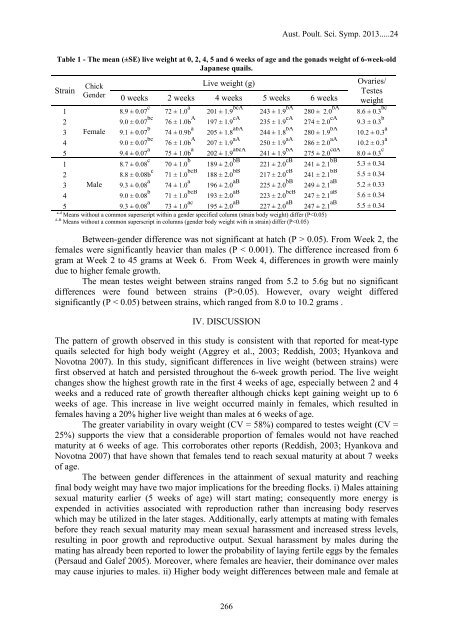APSS 2013 Proceedings - The University of Sydney
APSS 2013 Proceedings - The University of Sydney
APSS 2013 Proceedings - The University of Sydney
You also want an ePaper? Increase the reach of your titles
YUMPU automatically turns print PDFs into web optimized ePapers that Google loves.
Aust. Poult. Sci. Symp. <strong>2013</strong>.....24<br />
Table 1 - <strong>The</strong> mean (±SE) live weight at 0, 2, 4, 5 and 6 weeks <strong>of</strong> age and the gonads weight <strong>of</strong> 6-week-old<br />
Japanese quails.<br />
Strain<br />
Chick<br />
Live weight (g)<br />
Ovaries/<br />
Testes<br />
Gender 0 weeks 2 weeks 4 weeks 5 weeks 6 weeks weight<br />
1<br />
8.9 ± 0.07 c 72 ± 1.0 a 201 ± 1.9 bcA 243 ± 1.9 bA 280 ± 2.0 bA 8.6 ± 0.3 bc<br />
2 9.0 ± 0.07 bc 76 ± 1.0b A 197 ± 1.9 cA 235 ± 1.9 cA 274 ± 2.0 cA 9.3 ± 0.3 b<br />
3 Female 9.1 ± 0.07 b 74 ± 0.9b a 205 ± 1.8 abA 244 ± 1.8 bA 280 ± 1.9 bA 10.2 ± 0.3 a<br />
4 9.0 ± 0.07 bc 76 ± 1.0b A 207 ± 1.9 aA 250 ± 1.9 aA 286 ± 2.0 aA 10.2 ± 0.3 a<br />
5 9.4 ± 0.07 a 75 ± 1.0b a 202 ± 1.9 abcA 241 ± 1.9 bA 275 ± 2.0 cdA 8.0 ± 0.3 c<br />
1<br />
8.7 ± 0.08 c 70 ± 1.0 b 189 ± 2.0 bB 221 ± 2.0 cB 241 ± 2.1 bB 5.3 ± 0.34<br />
2 8.8 ± 0.08b c 71 ± 1.0 bcB 188 ± 2.0 bB 217 ± 2.0 cB 241 ± 2.1 bB 5.5 ± 0.34<br />
3 Male 9.3 ± 0.08 a 74 ± 1.0 a 196 ± 2.0 aB 225 ± 2.0 bB 249 ± 2.1 aB 5.2 ± 0.33<br />
4 9.0 ± 0.08 b 71 ± 1.0 bcB 193 ± 2.0 aB 223 ± 2.0 bcB 247 ± 2.1 aB 5.6 ± 0.34<br />
5 9.3 ± 0.08 a 73 ± 1.0 ac 195 ± 2.0 aB 227 ± 2.0 aB 247 ± 2.1 aB 5.5 ± 0.34<br />
a-d Means without a common superscript within a gender specified column (strain body weight) differ (P0.05). However, ovary weight differed<br />
significantly (P < 0.05) between strains, which ranged from 8.0 to 10.2 grams .<br />
IV. DISCUSSION<br />
<strong>The</strong> pattern <strong>of</strong> growth observed in this study is consistent with that reported for meat-type<br />
quails selected for high body weight (Aggrey et al., 2003; Reddish, 2003; Hyankova and<br />
Novotna 2007). In this study, significant differences in live weight (between strains) were<br />
first observed at hatch and persisted throughout the 6-week growth period. <strong>The</strong> live weight<br />
changes show the highest growth rate in the first 4 weeks <strong>of</strong> age, especially between 2 and 4<br />
weeks and a reduced rate <strong>of</strong> growth thereafter although chicks kept gaining weight up to 6<br />
weeks <strong>of</strong> age. This increase in live weight occurred mainly in females, which resulted in<br />
females having a 20% higher live weight than males at 6 weeks <strong>of</strong> age.<br />
<strong>The</strong> greater variability in ovary weight (CV = 58%) compared to testes weight (CV =<br />
25%) supports the view that a considerable proportion <strong>of</strong> females would not have reached<br />
maturity at 6 weeks <strong>of</strong> age. This corroborates other reports (Reddish, 2003; Hyankova and<br />
Novotna 2007) that have shown that females tend to reach sexual maturity at about 7 weeks<br />
<strong>of</strong> age.<br />
<strong>The</strong> between gender differences in the attainment <strong>of</strong> sexual maturity and reaching<br />
final body weight may have two major implications for the breeding flocks. i) Males attaining<br />
sexual maturity earlier (5 weeks <strong>of</strong> age) will start mating; consequently more energy is<br />
expended in activities associated with reproduction rather than increasing body reserves<br />
which may be utilized in the later stages. Additionally, early attempts at mating with females<br />
before they reach sexual maturity may mean sexual harassment and increased stress levels,<br />
resulting in poor growth and reproductive output. Sexual harassment by males during the<br />
mating has already been reported to lower the probability <strong>of</strong> laying fertile eggs by the females<br />
(Persaud and Galef 2005). Moreover, where females are heavier, their dominance over males<br />
may cause injuries to males. ii) Higher body weight differences between male and female at<br />
266
















